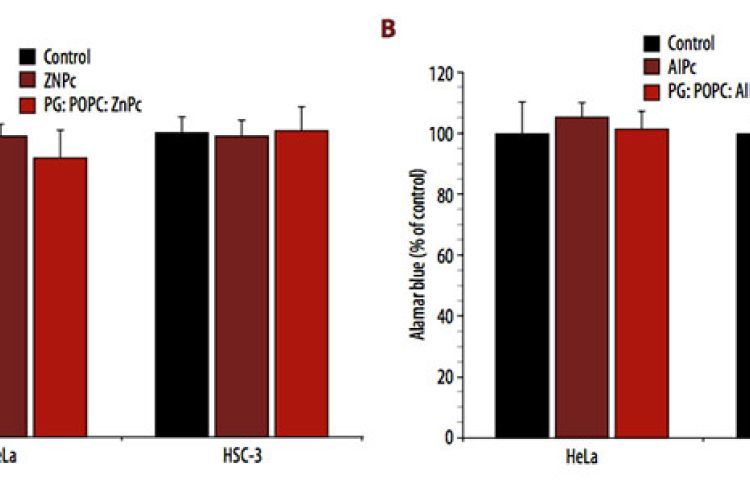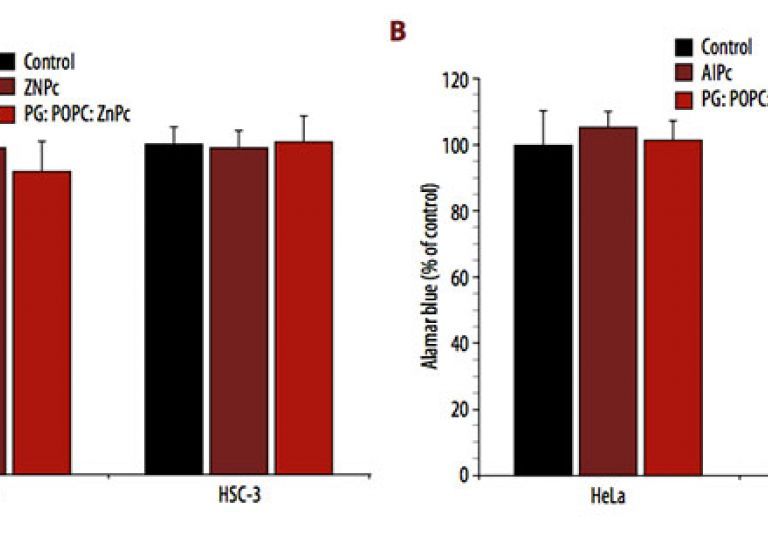Breadcrumb
Phototoxicity of Liposomal Zn- and Al-phthalocyanine Against Cervical and Oral Squamous Cell Carcinoma Cells In Vitro
What is it?
Research to see how two types of cancer cells respond to photodynamic therapy.
What problem does it aim to solve?
Oral cancer is a significant health problem around the world, and despite advances in treatment, life expectancy after diagnosis has not improved; the five-year survival rate remains stuck around 40% to 50%. Research in this area has been complicated by the fact that one type of cells used in oral cancer research was discovered to be contaminated with the HeLa cell line, which consists of cervical cancer cells.
How does it work?
In this study, the researchers focused on HeLa cervical carcinoma cells and human squamous carcinoma (HSC-3) oral cancer cells, studying the effects of two kinds of light therapy on cells incubated with phthalocyanine zinc salt (ZnPc) and aluminum phtalocyanine chloride (AIPc) respectively. Researchers divided each cell line into four groups and incubated one with free ZnPc, one with liposomal ZnPc, one with free AIPc and one with liposomal AIPc. They then exposed the cells to 20 minutes of phototherapy: The ZnPc-treated cells to broadband visible light from a 75-watt, 120V lightbulb (350-800 nm), and the AIPc-treated cells to light from a 9.8V high-powered LED bulb.
Liposomal ZnPc proved to be more effective at reducing cell viability in both lines than free ZnPc, and the HSC-3 cells were more sensitive to phototoxicity than the HeLa cells. Looking at AIPc's effects, again, liposome-embedded AIPc was more effective. However, HeLa cells were more vulnerable than HSC-3 cells.
The researchers also looked into the role of folate, because many epithelial cancer cell types produce an excess of folate receptors (FOLR1). HeLa cells were found to express high levels of FOLR1; HSC-3 cells did not.
What are the real-world implications?
Targeted phototherapy can help kill oral cancer cells as well as cervical cancer cells, and liposomes help enhance the toxicity of ZnPc and AIPc.
What are the next steps?
Because the HSC-3 cells turned out to lack folate receptors, other alternatives should be researched. Ultimately, these phototherapies need to be demonstrated to work safely in actual patients.

Dark toxicity of 1 µM free and liposomal ZnPc (A) and AlPc (B) on the viability of HeLa and HSC-3 cells. The metabolic activity was measured by the Alamar Blue assay and expressed as a percentage of the control (control cells). Each value is a mean ± standard deviation (SD) of 2 or 3 independent experiments performed in triplicate.
Source
"Phototoxicity of Liposomal Zn- and Al-phthalocyanine Against Cervical and Oral Squamous Cell Carcinoma Cells In Vitro", Med Sci Monit Basic Res 2016; 22:156-164
Authors
Jason Young, Michael Yee, Hayoung Kim, Jennifer Cheung, Takahiro Chino, Nejat Düzgüneş, Krystyna Konopka
Department of Biomedical Sciences, Arthur A. Dugoni School of Dentistry, University of the Pacific, San Francisco, USA






